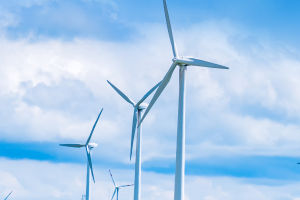Renewable energy refers to energy sources that can be continuously generated or regenerated within human timescales.
Unlike traditional fossil fuels such as coal, oil, and natural gas, renewable energy sources do not deplete resources or create ongoing pollution.
There are several common types of renewable energy:
1. Solar energy: This involves converting solar radiation into electricity or heat. Solar panels directly convert light energy into electricity, which can be used for power generation or to supply electricity to households. Solar thermal systems use solar energy to heat water or air.
2. Wind energy: Wind energy is converted into electricity by using wind turbines. These turbines are often installed in coastal areas, mountains, or vast plains to capture more wind energy.
3. Hydro energy: Hydro energy utilizes the flow of water or differences in water levels to generate kinetic energy, which is then converted into electrical energy. Hydroelectric power is typically generated through dams, water turbines, and hydroelectric power plants.
4. Biomass energy: Biomass energy is derived from plants, waste materials, or organic matter. For instance, wood, crop residues, or biowaste can be burned to produce heat or electricity.
5. Geothermal energy: Geothermal energy harnesses the heat from the Earth's interior to generate electricity or heat. Geothermal power plants and geothermal heat pump systems are used to utilize this energy source.
Renewable energy is characterized by sustainability and environmental friendliness. It helps reduce reliance on finite fossil fuel resources, as well as greenhouse gas emissions and air pollution, thereby combating climate change and environmental issues. Consequently, renewable energy is widely recognized as a crucial component of future energy supply.
Renewable energy finds applications in various fields. Here are examples of renewable energy applications in key sectors:
1. Electricity Production: Renewable energy is extensively used in electricity production. Solar photovoltaic systems and wind turbines are deployed in power plants and distributed generation systems, providing clean energy to the grid.
2. Transportation: The application of renewable energy is expanding in the transportation sector. Electric vehicles and hybrid vehicles utilize stored electricity in batteries for propulsion, while solar and wind energy can be employed to power charging stations.
3. Heating and Cooling: Solar thermal systems are employed for heating water and providing hot air. Geothermal heat pump systems utilize heat from the ground for heating and cooling buildings.
4. Agriculture and Rural Areas: Renewable energy plays a significant role in supplying electricity to rural areas, supporting agricultural activities and community development. Solar and biomass energy can be utilized for irrigation, livestock operations, and farm machinery.
5. Industrial Production: Renewable energy sources are increasingly adopted in the industrial sector. Solar and wind energy can provide power, heating, and cooling for industrial processes.
6. Buildings and Homes: Renewable energy is employed to supply electricity, heat, and hot water to buildings and residential properties. Solar photovoltaic systems and solar thermal systems can be installed on rooftops or facades.
These examples demonstrate the diverse applications of renewable energy. As technology continues to advance and gain wider adoption, the utilization of renewable energy is expected to expand further, promoting sustainable development and reducing dependence on traditional energy sources.


